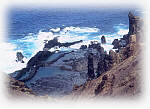An emerald set in bronze
St Helena is small yet beautiful. It is an island of contrasts, from
wind eroded desert with multi coloured ridges and valleys, to emerald
hillsides, soft pastures and lush vegetation filled valleys. It has
a magnificent bronze surrounding  coastline with 1000 feet high
cliffs that have been carved over the centuries by the pounding Atlantic
rollers. This ancient volcanic island is set in the tropical South Atlantic
1500 miles north-west of Cape Town. There is no airport and the island
can only be reached by ship. St Helena became a British dependency in
1834 and still retains its 19th century values and is imbued with some
300 years of colonial history; manifested in the architecture and ambience
of Jamestown.
coastline with 1000 feet high
cliffs that have been carved over the centuries by the pounding Atlantic
rollers. This ancient volcanic island is set in the tropical South Atlantic
1500 miles north-west of Cape Town. There is no airport and the island
can only be reached by ship. St Helena became a British dependency in
1834 and still retains its 19th century values and is imbued with some
300 years of colonial history; manifested in the architecture and ambience
of Jamestown.
A Georgian seaport
Protected by 18th century fortifications is Jamestown the island's capital,
a Georgian seaport which is abundantly endowed with a living heritage
from its early days. The town nestles in a deep narrow valley, is the
seat of Government and houses the museum, hotels and shops. The way
out of Jamestown by road is by one of two routes (Side Path and Ladder
Hill) each cut into steep hillsides. For the more adventurous, there
is Jacob Ladder with its 699 steps embedded into thte steep cliff face,
rising from the valley floor to the top of Ladder Hill.
The Discovery
Discovered 21 May 1502 by Portuguese admiral João da Nova on his return
voyage from India, the anniversary of Saint Helena mother of Emperor
Constantine. The island soon became a haven for sea travellers because
of its luxuriant vegetation, equable climate and wealth of fruit trees.
Ships would drop off those suffering from scurvy so that they could
benefit from the citrus fruits and then been picked up by another ship
after recovery. The Saints, as the islanders are affectionately known,
have their own special charm, having descended from British settlers
sent out by the East India Company, slaves and indentured workers from
Africa and the East. This amazing combination has contributed to the
Saints captivating, friendly and unique character.
Famous visitors
Over the centuries St Helena has welcomed many famous visitors among
them Darwin, Halley, Bligh, and Cook. The most internationally renowned
figure associated with St Helena is, of course, Napoleon Bonaparte who
was exiled to the island in 1815 following his defeat at the Battle
of Waterloo. he lived in Longwood House until his death in 1821, and
the residence is now a museum owned by the French Government.
Stamps
St Helena began issuing stamps in 1856. The discovery issue was released
in May 1997 and the fifth part in the serie will be released in May
this year - celebrating the 500th anniversary of the discovery of St
Helena.
Leisure activities
The island is ten and a half miles long and 6 and a half miles wide
is blessed with a pleasant climate with temperatures ranging between
14°C to 32°C in summer and 14°C to 26°C in winter. The island has a
rich history and a fascinating heritage evidenced by the early military
fortifications set in a spectacular scenery. There are superb walks
which can be gentle or ardous, offering a chance to see the endemic
flora and fauna. Visitors can enjoy the magnificent underwater scenry
by diving or snorkeling around our island but should note that they
must be accompanied by a local diver at all times. Spear fishing is
prohibited. Good sport can be had by fishing in our waters. Tuna, marlin
and barracuda are in abundance. If golf is essential part of your relaxation
you will enjoy the opportunity of playing 18 holes on one of the remotest
golf course in the South Atlantic.
Accomodation
There are three fully operational hotels: The Consulate and Wellington
House in Jamestown and Farm Lodge in the country. There is also a range
of self catering and bed & breakfast accomodation available in Jamestown
and the country areas. Pressure accomodation is at its peak during the
traditional summer holiday months of December and January.
Local cuisine
As with most isolated communities throughout the world St Helena has
developed its own unique multi ethnic cuisine. There are six eating
places on St Helena each with their own special character: Consulate
Hotel Tel: 2380; Wellington House Tel: 2529; Ann's Place Tel: 2797;
Dot's Cafe; C&M's Coffeee Shop Tel: 2730 in Jamestown and Farm Lodge,
St Paul's Tel: 4040.
Bank/Currency
St Helena currency is used on the island. Coins in use have values of
1p, 2p, 10p, 50p and £1. Notes in circulation have values of £5, £10
and £20. One St Helena £ is equal to One British £ Sterling. There are
no international banks but credit cards are now accepted in some
places with a small commission charge. Travellers cheques (1% commission
charge) are recommended.
Visa requirements
All visitors require valid passports and will normally be granted an
entry permit for a period of three months. Visitors must have a return
ticket and pre-booked accomodation. The entry permit may be extended
up to a period of one year.
| Find more about the latest news on St Helena Tourism on this link |
|
|
